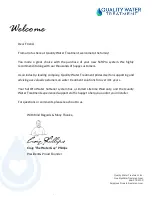
©2020 Quality Water Treatment. All rights reserved.
7
HOW A WATER SOFTENER WORKS
Water softeners remove hardness in the water by
exchanging particles in the water, or ions. They remove
hard ions the calcium and magnesium in the water by
trading it for sodium ions producing soft water. Unlike
the calcium and magnesium, sodium stays dissolved in
water and does not form a scale. Sodium also does not
interfere with the cleaning action of soaps. The sodium is
released by a charged resin contained in the softener,
this resin also traps the calcium and magnesium ions.
Eventually this resin releases all its sodium and has filled
up with other ions, so it then must be regenerated.
Regeneration is accomplished by washing the resin with
a salt saturated brine solution that removes the calcium
and magnesium while replenishing the sodium.
Therefore, the softener requires a brine tank and salt.
The water softener can run for days before running out
of sodium, and when it does, the sodium is replenished
in only a matter of a few hours.
NOTE:
Do not remove or destroy the serial number. It
must be referenced on request for warranty repair or
replacement.
CAUTION!
Do not use where the water is
microbiologically unsafe or with water of unknown
quality without adequate disinfection before or after the
unit. Applies to private well or surface water applications
only.
BEFORE INSTALLATION
All government codes and regulations governing the
installation of these devices must be observed.
Check your water hardness.
WARNING! ELECTRICAL SHOCK HAZARD! UNPLUG THE
UNIT BEFORE REMOVING THE COVER OR ACCESSING
ANY INTERNAL CONTROL PARTS.
CAUTION! The unit should be depressurized before
installing or replacing media.
COPPER PIPES - GROUNDING STRAPS:
If the ground from the electrical panel or breaker box to
the water meter or underground copper pipe is tied to
the copper water lines and these lines are cut during
installation of the Noryl bypass valve and/or poly pipe, an
approved grounding strap must be used between the
two lines that have been cut in order to maintain
continuity. The length of the grounding strap will depend
upon the number of units being installed and/or the
amount of copper pipe being replaced with plastic pipe.
In all cases where metal pipe was originally used and is
later interrupted by poly pipe or the Noryl bypass valve
or by physical separation, an approved ground clamp
with no less than #6 copper conductor must be used for
continuity, to maintain proper metallic pipe bonding.
CAUTION:
If the plumbing system is used as the
ground leg of the electric supply, continuity should
be maintained by installing ground straps around any
non-conductive plastic piping used in installation.
Check your local electrical code for the correct
clamp.
DRAIN LINE INFORMATION
Waste connections or drain outlets shall be designed and
constructed to provide for connection to the sanitary
waste system through an air gap of 2 pipe diameters or 1
inch (22 mm) whichever is larger.
Never insert a drain line directly into a drain, sewer line,
or trap. Always allow an air gap between the drain line
and the wastewater to prevent the possibility of sewage
being back-siphoned into the softener.
WATER PRESSURE INFORMATION
Applies to private well or surface water applications only.
If a severe loss in water pressure is observed when the
Softener unit is initially placed in service, the softener
tank may have been laid on its side during transit. If this
occurs, backwash the softener to “reclassify” the media.
Check Your Water Pressure and Pumping Rate -
Two
water system conditions must be checked carefully to
avoid unsatisfactory operation or equipment damage:
Minimum water pressure required at the
Softener tank inlet is 30 psi.






















